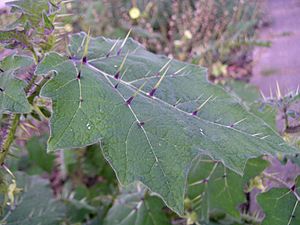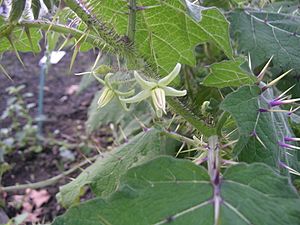Solanum myriacanthum facts for kids
Quick facts for kids Solanum myriacanthum |
|
|---|---|
 |
|
| Close up of leaf | |
 |
|
| Flower buds | |
| Scientific classification | |
| Genus: |
Solanum
|
| Species: |
myriacanthum
|
| Synonyms | |
|
|
Solanum myriacanthum, also known as the Himalayan nightshade, is a type of flowering plant. It belongs to the Solanaceae family, which includes many well-known plants like tomatoes, potatoes, and peppers. This plant is special because it has thorns and can grow quite large.
The Himalayan nightshade originally comes from Mexico and Central America. Over time, it has spread to other parts of the world. You can now find it in places like Cuba, Nepal, Assam in India, and Myanmar. Sometimes, it can even grow very quickly and take over areas, like in the southeastern United States.
Contents
What is Solanum myriacanthum?
Solanum myriacanthum is a plant that stands out because of its thorny stems and leaves. It can grow up to 2 meters (about 6.5 feet) tall. The plant has large, lobed leaves that are also covered in spines. These spines help protect the plant from animals that might want to eat it.
Flowers and Fruits
The flowers of the Himalayan nightshade are usually white or light purple. They grow in clusters and have a star-like shape. After the flowers bloom, the plant produces small, round fruits. These fruits are green when they are young and turn yellow or orange as they ripen. It is important to know that many plants in the Solanum family have fruits that are not safe to eat.
Plant Parts and Features
The leaves of Solanum myriacanthum are quite big. They can be up to 30 centimeters (about 12 inches) long. Both the top and bottom of the leaves have sharp thorns. The stems are also covered in these thorns, making the plant difficult to handle without protection.
Where Does It Grow?
This plant prefers warm climates. It grows well in areas with plenty of sunshine and moisture. In its native regions of Mexico and Central America, it can be found in forests and open fields. When it spreads to new places, it often grows in disturbed areas, like roadsides or abandoned farms.
Native Home
The plant's original home is in the tropical and subtropical regions of Mexico and Central America. This includes countries like Guatemala, Honduras, and Costa Rica. The warm weather and fertile soil in these areas are perfect for its growth.
Spreading to New Places
Over time, Solanum myriacanthum has been introduced to other parts of the world. This can happen in different ways, such as seeds being carried by animals or people. Once it arrives in a new place, if the conditions are right, it can start to grow and spread.
Invasive Tendencies
In some areas, like the southeastern United States, Solanum myriacanthum is considered an "invasive" species. This means it can grow very quickly and outcompete native plants for resources like sunlight and water. When an invasive plant spreads too much, it can change the natural balance of an ecosystem.
Plant Life Cycle
Like many flowering plants, Solanum myriacanthum goes through a full life cycle. It starts as a seed, grows into a plant, produces flowers, makes fruits with new seeds, and then the cycle repeats.
Reproduction
The plant reproduces by seeds. The flowers are pollinated, which means pollen is carried from one flower to another. This leads to the development of the fruits, which contain the seeds. Animals or birds might eat the fruits and then spread the seeds to new locations through their droppings.
See also
 You can learn more about this plant in Spanish here: Solanum myriacanthum para niños
You can learn more about this plant in Spanish here: Solanum myriacanthum para niños

